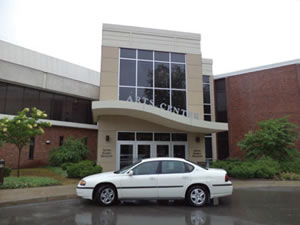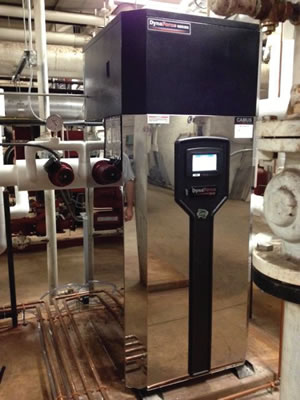Business Managing Higher Ed
Partnering for Energy Savings
- By Ellen Kollie
- August 1st, 2014

PHOTOS COURTESY OF NAZARETH COLLEGE
Nazareth College, an independent institution with 2,000 undergraduate and 800 graduate students in Rochester, NY, is committed to sustainability. In 2008, the college established the Campus Sustainability Task Force, which didn’t waste any time getting to work. In 2009, the Task Force published the GreenPrint@Naz Report (available for download at www.naz.edu), which contains customized recommendations on a plan for reducing consumption of natural resources and for moving toward campus climate neutrality. “GreenPrint is the ‘blueprint’ for our campus sustainability efforts,” says Michael LaPoint, Nazareth’s director of Construction and Renovation Services.
Since GreenPrint, Nazareth administrators have completed two projects, and are in the process of completing a third, that exemplify their sustainability commitment. The first project is Peckham Hall, a 74,000-square-foot academic facility completed in 2012. Boasting state-of-the-art science labs, classrooms and open spaces, construction included design and installation of an energy-efficient building shell, high-performance windows, energy-efficient lighting, occupancy sensor controls and an energy-efficient heating and HVAC system.
The second project was replacing boilers in the Arts Center, which was completed in 2013. The third project is replacing boilers in the main boiler plant, which is started and expected to be complete in the next two to three years, as funding is available.
The Relationship
Nazareth administrators received substantial technical support and funding assistance to identify and implement these initiatives by working with Albany-based New York State Energy Research and Development Authority (NYSERDA). NYSERDA, a public benefit corporation, offers objective information and analysis, innovative programs, technical expertise and funding to help New Yorkers increase energy efficiency, save money, use renewable energy and reduce reliance on fossil fuels. With regional offices in Buffalo, New York City and West Valley, NYSERDA has been developing partnerships to advance innovative energy solutions in New York State since 1975.
More specifically, NYSERDA has a Commercial New Construction Program and an Existing Facilities Program, both of which Nazareth used and is using to complete the above-mentioned projects. The Commercial New Construction Program provides technical support to design teams and financial incentives to commercial and industrial building owners who are planning the construction of new structures.
“Our goal simply is to deliver better buildings, those that provide better learning/working environments, less impact on environment and cost less to operate,” says Priscilla Richards, LC, NYSERDA’s program manager for New Construction. “Our primary means for doing that is providing technical assistance and financial assistance focused around energy efficiency opportunities and sustainability measures.”
The Existing Facilities Program offers a broad portfolio of incentives to help offset the costs of implementing energy efficiency improvements in existing commercial facilities. Since it began in 1999, the program has helped clarify priority projects and maximize incentives for thousands of facilities. “I address opportunities to invest in energy efficiency,” says Scott Smith, NYSERDA’s program manager for Implementation Services. “I work to build long-term relationships with customers to help them meet business and sustainability goals. My primary objective is to help them do what they do better.
“We have been working with Nazareth off and on for a decade,” continues Smith. “Most recently we started engaging them in a long-term relationship in 2010. A large driver for both of our interests is Nazareth’s commitment to reducing carbon emissions, as indicated in GreenPrint@Naz, and we’ve been working together to implement some of those recommendations.”
“Working with NYSERDA is not optional,” confirms LaPoint, who has worked with NYSERDA since arriving at Nazareth six years ago and whose first project with the organization was the renovation of the Arts Center, which was completed in 2009. “It is part of our standard operating procedures. We’ve done several large and small projects with them, and we are quite familiar with their programs now.
“What I have come to expect from NYSERDA,” LaPoint continues, “is that they will answer my questions from a project’s very beginning. We start with a scoping meeting with our liaison, Webster, NYbased Sustainable Performance Consulting, and the engineers, to identify what rebates will be available, what methods to use and what must be accomplished with the applications. When I have a question through the course of a project, I call, and I get answers.”
In collaborating on these projects, Nazareth and NYSERDA engaged the design team early in the process, allowing NYSERDA to work as part of the team to recommend and discuss efficiency opportunities that were integrated into the design program. “We identified cost and benefits through energy modeling,” says Richards. “The most important part is seeing the cost savings year after year, which are delivered to the students in terms of savings and educational opportunities.” Smith agrees, noting that NYSERDA’s financial incentives helped the team accelerate the timeline and scope of the projects to maximize energy savings benefits.

PHOTOS COURTESY OF NAZARETH COLLEGE
WITH A LITTLE HELP FROM MY FRIENDS. Nazareth College received technical support and funding assistance to identify and implement energy-saving initiatives by working with the New York State Energy Research and Development Authority (NYSERDA) under its New Construction Program and Existing Facilities Program. As part of the process, Nazareth’s Arts Center and main boiler plant projects underwent replacements of boilers with energyeffi cient models and upgrades to the main boiler plant, which provides steam to 85 percent of the campus.
The Rewards
As a result of the relationship between Nazareth and NYSERDA, the three projects had overall projected annual energy cost savings of more than $441,000 and avoid 1,300 tons of greenhouse gas emissions each year. Peckham Hall alone is operating 37.7 percent more efficiently than ASHRAE 90.1-07.
In addition, Peckham Hall “received designation as a High Performance Building from NYSERDA,” says LaPoint. “Maybe five to 10 percent of the buildings that go through the program meet the standard for the level of energy savings that we’re anticipating. It’s a nice surprise to find out we exceeded most of the expectations from NYSERDA’s point of view.”
The Nazareth/NYSERDA relationship produced three additional surprises on these projects. One is the rebate, which LaPoint says is in the $200,000 range. The second is that Peckham Hall won a Construction Specifications Institute (Alexandria, VA) award, and AIA Rochester gave it a Design Excellence Merit Award in the Institutional Category.
The third surprise is that Peckham Hall is expected to receive LEED Silver certification, the first building on campus and in the town of Pittsford, NY, to achieve the rating. LaPoint is quick to credit Erdman Anthony (EA) with assistance. EA is a multidisciplinary firm specializing in infrastructure engineering and support services, with offices in New York, Pennsylvania, Maine and Florida. “I hired EA to do the advance commissioning, and they also worked with NYSERDA as a technical assistant,” he says. “We were able to overlap LEED and NYSERDA requirements. The LEED certification was one thing I wasn’t expecting. It was a bonus.”
Stantec, an architectural firm with offices around the world, also gets credit for contributing to Peckham Hall’s success. “The energy demands are significant in laboratory environments, and especially so in a building full of science classrooms,” observes Krista Van Wassen, LEED-AP, interior design coordinator with Stantec. “It was a tremendous success that the energy cost savings are projected at more than 33 percent over a code-compliant building, which exceeded our initial estimates.”
Everyone involved in the Nazareth projects note that a commitment to sustainability is incredibly satisfying, and reducing the carbon footprint and saving energy are great rewards for work well done. But it’s the relationship that allows the work to be done in the first place. “It’s satisfying to help customers finalize and refine a plan and walk with them through a systematic process of implementing the plan to achieve their goals,” Smith says. “These long-term relationships help integrate clean energy into everyday lives.”
GOING GREEN AT NAZARETH
Nazareth College administrators have been aggressive in their energy management, accomplishing a number of green initiatives, including:
- installing energy-efficient motors, lights, boilers and chillers;
- installing variable-speed motor drives;
- using computerized energy management systems to lower/raise temperatures and turn air-moving equipment on/off based on occupancy;
- installing low-flow toilets, sinks and shower faucets;
- setting back residence hall temperatures during the low-occupancy month of December;
- recycling;
- upgrading insulation, windows and doors;
- using environmentally safe cleaning products; and
- operating a green fleet that includes four electric cars and two electric golf carts.
This article originally appeared in the August 2014 issue of College Planning & Management.